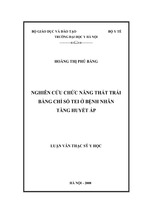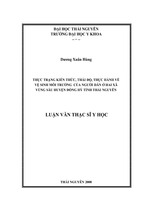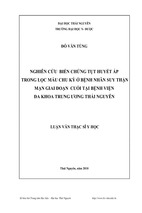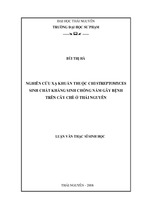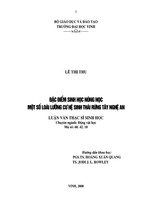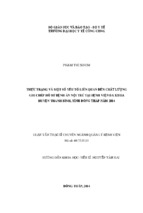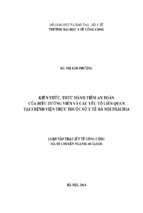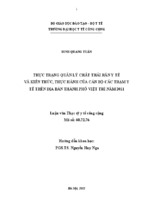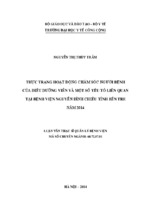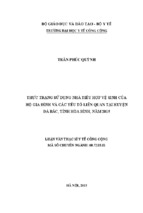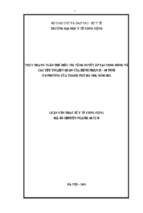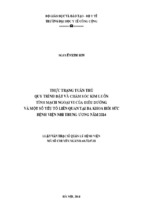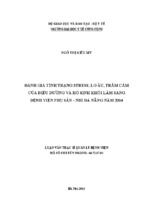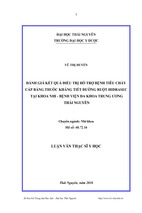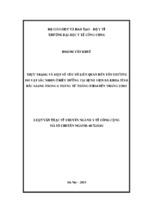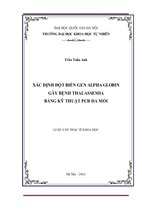Economic Impact of Bridge Damage in A Flood Event
A thesis submitted in fulfilment of the requirements for the degree of Master by Research
YUE ZHANG
Bachelor of Engineering Management, HuaiHai Technology Institution
School of Civil Environmental and Chemical Engineering
College of Science Engineering and Health
RMIT University
August 2016
Declaration
I certify that except where due acknowledgement has been made, the work is that of the author alone;
the work has not been submitted previously, in whole or in part, to qualify for any other academic
award; the content of the thesis is the result of work which has been carried out since the official
commencement date of the approved research program; any editorial work, paid or unpaid, carried
out by a third party is acknowledged; and, ethics procedures and guidelines have been followed.
ZHANG YUE
14/11/2016
ABSTRACT
Bridges are vulnerable road infrastructure in flood events. Different level damage of bridge
can be observed after flood events. As lifeline structures, bridge plays an important role in
any road network. Bridge structures involve both great construction costs and great economic
value to stakeholders. Despite costs for post-disaster clearance and repair of bridge structures,
a decrease in the accessibility of bridges would have a significant impact on regional traffic,
residents and businesses. Current knowledge still has gap on fully recognizing and
understanding economic impacts of bridge damage. In addition, there was a lack of accurate,
detailed and sufficient data as well as validated model that could be used to estimate all types
of economic impacts. This research would base on a critical review of existing literature to
solve two problems of understanding economic impacts of bridge damage:
What are the economic impacts of bridge damage in flood events? How to categorize these
economic impacts systematically?
How can these economic losses be measured?
An in-depth understanding of the effects of bridge damage is required in order to develop
estimation methods as well as sustainable management and adaptation strategies.
This research reviews and summarizes current knowledge on consequences that can be
caused by bridge damage due to flood events. Each consequence is discussed and analysed.
Likewise, this study systematically categorizes different types of potential economic impacts
to bridge stakeholders and local councils into direct tangible/intangible and indirect
tangible/intangible types.
In terms of measuring different types of economic impacts, it is still a great challenge due to
the present knowledge gap. This research introduces and integrates existing models in
different areas to measure economic impacts that are resulted from bridge damages. For the
economic losses of bridge damage and recovery, this research discusses damage states, repair
quantities, repair methods and repair costs, which provides guides for the stakeholders to
predict repair costs and time limits of recovery projects. For the economic losses of bridge
accessibility, this research concerns indirect tangible economic impacts, which include the
detour of bridge users and the business interruption. In terms of detour costs of bridge users,
I
models prefer to use regional road networks, average local vehicle operating costs, postdisaster traffic conditions and alternative path choice to estimate the costs of the extra
traveling and the opportunity costs of the extra traveling time. With regards to business
interruption, this research measures business interruption and the decrease of productive
capacity due to bridge damage.
Although most economic losses can be estimated by monetary flow, some types of economic
losses need to be measured or interpreted in terms of consumption of social resources after
bridge damage. This research also makes efforts to understand these economic impacts, such
as the value of a historical bridge, impacts on the labour market change and losing the trust of
authority.
To illustrate the application of integrating models, Kapernicks Bridge, which is located in
Queensland and continues to be damaged as a result of floods in the Lockyer Valley region,
is introduced as a case study in this research. In this case study, economic impacts that are
summarized are discussed and estimated by the integrated model. In this part, estimation
focuses on the costs of extra travel and the opportunity costs of extra travel time. This case
study makes two main contributions. First of all, models apply regional data and figure out
current data and knowledge gaps leading to model validation. Second, this case study can
also be used as a guide to help stakeholders estimate their economic losses due to bridge
damage after flood events. Therefore, a focused strategy can be made to decrease losses in
the most disaster-affected region.
This research has two main contributions to current knowledge. The first one is its definition
of economic impacts of bridge damage in a flood event. The second one is its application of
existing knowledge and models to measure the majority of these economic impacts. Future
research can focus on understanding the relations between damage states, repair methods, and
repair quantities. Also, future research can make a contribution to knowledge of measuring
losing trust on authorities.
II
ACKNOWLEDGEMENTS
This master program started in June 2014, when I decided to transfer to the construction
school to continue my studies. I found research direction on natural disasters and their
economic impacts when I browsed research projects in RMIT research programme. Since
1998, there have been lots of flood events and natural disasters reported by the press. I began
to realize that these catastrophes created significant economic losses and brought pain to
victims. When I discussed with Associated Professor Kevin Zhang about his project on the
economic impacts of natural disasters and the resilience of the local community, he
recommended research topics and supported me in conducting research on one part of the
economic impacts of natural disasters. I would like to take part in and make a contribution to
understanding the effects of natural disasters.
My research has been directed by Associated Professor Kevin Zhang. He provided a lot of
help in this study. His supportive advice and critical comments guided this research. In the
beginning, this research set too ambitious research topics and scopes that included as many
economic impacts as I could review. He helps me to narrow down my research scope and set
proper and attainable objectives. During research, my supervisor provided valuable
suggestions and comments to help me to improve my research by introducing appropriate
concepts and models. He organised weekly meetings to help me to identify components of
economic impact, classification of economic impacts and introduce appropriate models.
Thanks to my associate supervisor Hessam Mohseni, who provides a lot of useful
recommendations to help me improve my research. As one of the principals in the CRC
project on economic impacts of road infrastructures that are damaged in natural disasters, he
has comprehensive knowledge of road infrastructures. He guided me in identifying economic
impacts and classifying economic impacts properly. To improve my knowledge of bridge
damage in flood events and collect proper data, he contacted the local council to help me
obtain post-disaster information. Also, he took me to Brisbane to gather information
personally. I got a valuable chance to visit the local council to talk about post-disaster
response and recovery. I also use this chance to check road networks around damaged bridges.
III
Also thanks to CRC (Cooperative Research Centres), who organised cooperative research
work on the resilience of road infrastructure in flood events. I appreciate the encouragement
and support from these organisations. It was my pleasure to have had the opportunity to join
and make my contribution to this project. Also, this research got benefits from the
cooperation works. CRC shared and provided important and valuable data that would be
important to this research. The first and second report interpret concepts related to road
infrastructure resilience, the importance of road infrastructure and impacts that are created by
accessibility. These two reports summarized previous research and presented the findings
from the interviews conducted with victims from flood-affected regions. All these types of
information are a significant help to this study.
This researcher also appreciates the support of the Lockyer Valley local council. The local
council provided the necessary data in detailed, including steel bracing drawings, bridge
inspection reports conducted a year after bridge damage, and information about road network
conditions and post-disaster traffic situations. Also, the local council shared some critical
information on post-disaster conditions, which would help considerably in predicting postdisaster debris quantities, bridge repair, and recovery needs, post-disasters travel information,
etc. Furthermore, the local council provided some valuable contact information to help me
collect necessary information.
I enjoyed my time at RMIT. Thanks to the friendly staffs at RMIT. They provided assistance
and support to me. Special thanks goes to my office mates, who helped me learn about
English and Australian cultures. They offered kindness and friendship to me.
I am grateful my younger sisters. Their love, encouragement and support helped me finish
this thesis. My family made me feel beloved throughout my years in Melbourne.
Melbourne, August 2016
YUE ZHANG
IV
V
Contents
CHAPTER1
INTRODUCTION ............................................................................................ 1
1.1
Background ................................................................................................................. 1
1.2
Flood as one of the main threats to bridge .................................................................. 3
1.2.1
More flood events in the near future .................................................................... 3
1.2.2
Distribution of cities and flood events ................................................................. 6
1.3 The impacts of road infrastructure destruction on the local community in natural
disaster.................................................................................................................................. 10
1.4
Bridge damage in flood events .................................................................................. 11
1.5 Measure the economic impacts after flood events and the rationale of estimating
economic impacts of the bridge destruction ......................................................................... 14
1.5.1
Measuring the economic impacts....................................................................... 14
1.5.2
The importance of estimating economic impacts of bridge damage ................. 15
1.6
Research questions and objectives ............................................................................ 15
1.6.1
Research questions ............................................................................................. 15
1.6.2
Research objectives ............................................................................................ 17
1.6.3
Research significance......................................................................................... 17
1.7
Outline of the thesis................................................................................................... 18
CHAPTER2
2.1
LITERATURE REVIEW ............................................................................... 20
Natural disasters and disaster impact ........................................................................ 20
2.1.1
Classification of the economic impacts ............................................................. 22
2.1.2
Economic impacts of road infrastructure disruption in natural disasters ........... 24
2.1.3
Significance of bridges in road infrastructure .................................................... 25
2.2
Bridge damages and access ....................................................................................... 26
2.2.1
Debris and debris clearance after flood events .................................................. 27
2.2.2
Bridge structural damage after floods ................................................................ 29
2.3
Model review............................................................................................................. 35
2.3.1
Bridge repair costs ............................................................................................. 36
2.3.2
Value of historical bridge................................................................................... 41
2.3.3
Indirect cost ........................................................................................................ 43
2.3.4
Loss of the accessibility ..................................................................................... 46
VI
2.3.5
2.4
Some other economic losses and estimation methods ....................................... 48
Conclusion................................................................................................................. 50
2.4.1
Limitations and challenges of current research ................................................. 50
2.4.2
Model choosing .................................................................................................. 52
CHAPTER3
3.1
METHODOLOGY ......................................................................................... 54
Research design ......................................................................................................... 54
3.1.1
Purpose of the study ........................................................................................... 54
3.1.2
Extent of researcher interference with this study ............................................... 55
3.2
Data collection........................................................................................................... 63
3.2.1
Data collection methods ..................................................................................... 65
3.2.2
Main data source review .................................................................................... 68
CHAPTER4
4.1
IMPACTS IDENTIFICATION AND CLASSIFICATION .......................... 71
Economic impacts identification ............................................................................... 71
4.1.1
The main economic impacts of bridge damage after floods .............................. 72
4.1.2
Causes and effects analysis ................................................................................ 85
4.1.3
Categorize different classification of economic impacts of bridge damage in
flood events....................................................................................................................... 87
CHAPTER5 INTEGRATED MODELS TO ESTIMATE ECONOMIC IMPACTS OF
BRIDGE DAMAGE IN FLOOD EVENTS ............................................................................ 91
5.1
Introduction ............................................................................................................... 91
5.2
The performance group and bridge damage states of concrete bridge ...................... 92
5.2.1
Structure performance group ............................................................................. 93
5.2.2
Damage state of performance group .................................................................. 96
5.3
Regional vehicle operating costs ............................................................................... 98
5.3.1
5.4
Estimate regional vehicle operating costs .......................................................... 99
Debris disposal costs ............................................................................................... 103
5.4.1
Recycling construction waste .......................................................................... 104
5.4.2
Putrescible debris ............................................................................................. 105
5.5
Maps of regional road systems ................................................................................ 110
5.6
The Estimation of economic costs of concrete bridge damage ............................... 118
5.6.1
The direct tangible costs .................................................................................. 119
5.6.2
Direct intangible losses .................................................................................... 122
5.6.3
Indirect tangible costs ...................................................................................... 125
5.6.4
Indirect intangible costs ................................................................................... 127
VII
CHAPTER6
6.1
CASE STUDY ............................................................................................. 130
General condition of case study .............................................................................. 130
6.1.1
Objectives of the case study............................................................................. 131
6.1.2
Data sources and the main constraints ............................................................. 132
6.2
Bridge performance group and damage states of performance groups ................... 134
6.2.1
Damage states of Kapernicks Bridge ............................................................... 141
6.3
Regional vehicle operating costs ............................................................................. 148
6.4
Debris disposal costs ............................................................................................... 161
6.5
GIS map development and surrounding road networks .......................................... 162
6.6
Economic impacts of damaged bridge .................................................................... 172
6.6.1
Direct economic costs ...................................................................................... 172
6.6.2
Direct intangible losses .................................................................................... 175
6.6.3
Indirect tangible losses ..................................................................................... 177
6.6.4
Indirect intangible losses.................................................................................. 184
CHAPTER7
Conclusions, Contributions, and Implications ............................................. 189
7.1
Introduction ............................................................................................................. 189
7.2
Conclusions regarding objectives............................................................................ 189
7.2.1
Objective 1: Impacts identification .................................................................. 190
7.2.2
Objective 2: Impacts classification .................................................................. 192
7.2.3
Objective 3: Model Development .................................................................... 192
7.2.4
Objective 4: Case study ................................................................................... 195
7.3
Contributions to the Academic Knowledge Base ................................................... 195
7.4
Implications in Practice ........................................................................................... 196
7.5
Study limitations ..................................................................................................... 198
7.6
Recommendations for future Research ................................................................... 200
7.7
Closure .................................................................................................................... 201
CHAPTER8
APPENDIX .................................................................................................. 203
CHAPTER9
REFERENCE ............................................................................................... 209
VIII
CHAPTER1
INTRODUCTION
1.1 Background
Road infrastructure throughout Australia is crucial to the Australian economy (Merick 2008).
Road networks provide accessibility and support regional transportation. There is a direct
correlation between growth in the demand for freight and passenger transport with growth in
incomes (Economics 2007). With the increase in population and size of the economy, there is
also growth of traffic demand in Australia. The primary value of roads to the local
community can be interpreted as accessibility which assures social connection, business
production, and the collective action. It connects employees with places of work, people with
leisure activities, resources with centres of production, products with markets and consumers,
etc (Merick 2008). Also, other types of infrastructure facilities rely on road infrastructures,
for example, sewer, power, water, the internet, etc. Road in the most important lifeline in
Australia.
In a road network, the bridge is a critical component (Padgett et al. 2008). It always connects
two road networks or provides traffic diversion that can reduce traffic congestion, travel time
and distance (Gentle, Kierce & Nitz 2001; Hallegatte & Przyluski 2010). Bridge value can be
described as two parts: The first part is decided by its construction cost, which is also called
assets value. In general, the construction of bridges involve great costs. For example, the
Yeppen South project would cost 256 million AUD (Figure 1.1). The second part is the
economic value of accessibility that is provided to stakeholders. Bridge closures will isolate
two connected road networks. Disruption at the bridge can separate some rural areas
accidently in some extreme conditions. According to a 2010 research report, the economic
value of a bridge is much larger than its assets value, and the adverse effects on the local
community cannot be easily measured in monetary terms (Hallegatte & Przyluski 2010).
1
Figure 1.1 Yeppen Bridge in Queensland (Ahmad 2006)
During the life cycle of bridges, the main threats are due to natural hazards. Natural hazards
have the potential capacity to destroy both the physical body and accessibility of the bridge.
Despite repairing the damaged physical body of the bridge after flood events, there are some
potential losses due to decreasing bridge accessibility. Reduced accessibility means the
disruption of traffic, leading to regular daily objectives, such as work, school, food, fuel,
medical consultants, entertainment are not reachable or lack approaches (Greenberg, Lahr &
Mantell). Also, accessibility is critical to the resilience of the local community. Loss of
accessibility can lead to a delay in post-disaster rehabilitation after flood events.
Rehabilitation of associated facilities, such as power, sewer, and the internet often rely on the
bridges and other types of road infrastructure.
As a flood-vulnerable country, Australia has suffered from flood events (Guha-Sapir et al.
2011). There were 26 main flood events from January 2000 to July 2015. The expenditures
that were calculated by the insurance companies for rehabilitation after disasters amounted to
2
4,329.5 million AUD (Australian Institute of Disaster Resilience 2015). In these flood events,
lots of bridges were damaged or destroyed. According to a report from the Queensland
government, critical road networks were damaged in almost every flood event (Repo 2012).
In 2013, forty-two bridges were damaged in the Lockyer Valley region in Queensland. The
economic costs of bridge damage are hard to predict. The figure that is calculated by the
insurance company can not adequately reflect economic losses of bridge damage in flood
events, as they only calculate properties that are covered by their insurance clauses.
1.2 Flood as one of the main threats to bridge
A flood event is one of the main threats that can affect the health and condition of road
infrastructure most negatively (Hughes 2003; Koetse & Rietveld 2009). Australia is a floodvulnerable country. The majority of bridges are threatened by risks of exposure and damage
due to flood events. Australian has acquired the experience to improve the resilience of
critical infrastructure after disaster events (Croope & McNeil 2011). However, the
destruction of critical road networks still happens in almost every flood event in Queensland
(Repo 2012). It has been investigated in post-disaster reports in Australia that many road
structures have been affected by floods in flood-prone areas such as Queensland. However, in
light of climate change and the population growth in Australia, the frequency, intensity, and
the impacts of floods will increase.
1.2.1
More flood events in the near future
In Australia, flood events are high-frequency natural disasters. As one of the most
catastrophic natural disasters, the flood can cause severe damage to road infrastructure.
According to the report, heatwaves and flood events are considered to be natural hazards
which will damage the road infrastructure the most (Hughes 2003). In this research, the
damage caused by flood is the primary concern. A flood event is defined byGeoscience
Australia as “a general and temporary condition of partial or complete inundation of normally
dry land areas from overflow of inland or tidal waters from the unusual and rapid
accumulation or runoff of surface waters from any source” (Australian Government of
Geoscience Australia 2016). The causes of flood events are various. Floods can originate
3
from the sea (coastal floods), from rivers (fluvial floods), from heavy rain events (pluvial
floods) or from below the surface (groundwater floods) (Klijn 2009). Floods are widely
distributed throughout all the large population areas in the Australia (Figure 1.2). The average
annual direct cost of floods has been estimated at AUD370 million (BITRE 2008). The rainy
season and tsunami bring floods almost every year around the coastal area. The increasing
flood events will have implications for the bridges. According to the EM-DAT, there were
forty-two severe floods recorded from 1990 to 2015, nearly 2.8 flood events on average per
year. These flood events led to the death of 117 people, 89 injured, and 292939 people
affected people (EM-DAT Database 2009).
Figure 1.2 The distribution of flood events in Australia(Australian Government of Geoscience
Australia)
4
The climate report claims that Australia will suffer more flood and extreme weather events
shortly (Guha-Sapir et al. 2011; Hughes 2003). The increasing intensity and frequency of
natural disasters, which are created by climate change, are pessimistic to road infrastructure
and increase the possibilities of losses in these natural disasters (Bankoff, Frerks & Hilhorst
2004). Extreme events, especially bush fires, heat waves and floods, will increase in both
frequency and intensity (Hughes 2003). Though the climate will become drier in Australia,
the heavy storm and flood event will happen more frequently because of the extreme
temperature change. Table 1.1 shows the increasing flood events in the recent two decades
(EM-DAT Database 2009). Specifically, the most noticeable change is that the average
extreme hot day is increasing, and the eastern part of Australia will become dryer while the
western part of Australia will suffer more very heavy rain. It seems that the road
infrastructure will be exposed to more risks from storms and flood events in the near future.
Table 1.1 Statistics of flood events
Time period
Number of flood events
1976-1985
9
1986-1995
8
1996-2005
22
2006-2015
17
Another reason that will lead to more flood events is that the increasing sea levels will
increase the risks of exposing cities to a tsunami, rainstorm, and high tide events. The sea
level has already increased 20- 60cm above the 1990 levels due to the global warming and
they will continually increase (Guha-Sapir & Hoyois 2014). The direct effect is that the
fringe part of the continent will be submerged. Some buildings and road infrastructures will
become vulnerable. The straight line distances between the coastal cities and the coastline
have also become shorter, which will exacerbate the adverse effects of ocean disasters.
5
1.2.2 Distribution of cities and flood events
In Australia, the majority of the cities and populations located around coastal lines.
According to the population distribution research, the majority of Australians live within 50
KM of the coast (Hugo 2003) (Figure 1.3). Similarly, road infrastructure and support
facilities are more intensive in high population density regions (Figure 1.4). Road
infrastructure seems easily impacted by extreme coastal weather. According to the Bureau of
Meteorology (BOM) Australia 2011, dynamic river flood maps (Figure 1.5) are quite similar
to the allocation of road networks. It is evident that road infrastructure suffered in almost all
flood events in the past. Bridges, as part of the road network, are also exposed to flood events.
Figure 1.3 Cities distribution of Australia(ABS 2010a July 2011)
6
Figure 1.4 Distribution of road infrastructure (Jennifer Baxter March 2011)
7
Figure 1.5 Flood events distribution(Australia Government Bureau of Meteorology 2011)
In the past few years, population increases have brought more residents, mainly of the
younger generation, to coastal areas than anywhere else. The growing population would lead
to a more vulnerable population that will suffer flood events. The increased demands on
transportation in the coastal region produce more intensive road network around coastal
zones (Hugo 2003). The increasing density of road networks would increase the number of
bridges that are exposed to the extreme storm and flood events (Bankoff, Frerks & Hilhorst
2004). Also, the costs of recovering bridges that are damaged in flood events would be higher
due to higher labour costs, the application of new technology, a larger building scale, the
need for more overpasses and associated facilities, etc. All these reasons above will lead to a
higher post-disaster recovery cost.
8
Mitigation disaster relocation has been discussed, studied and observed for several years. It is
believed to be the most effective disaster mitigation method to keep local communities away
permanently from high-frequency, predictable severe natural disasters permanently and
reduce long-term rehabilitation costs after flood events (Perry & Lindell 1997). It is applied
by different counties after different types of natural disasters as well as in disaster prone areas.
Some local councils have been trying to relocate some of the communities residing in
disaster-prone areas. For example, Darwin move out residents for disaster mitigation purpose
in 1979 (Perry & Lindell 1997). The Federal Emergency Management Agency even has a
disaster mitigation relocaiton programs serves residents in disaster vulnerable reigon in the
united states. In Japan, there is an Act on Special Financial Support for Promoting Group
Relocation for Disaster Mitigation. However, relocation and evacuation the local community
in disaster-prone area is not often conducted vary successfully. There are two reasons: On the
one hand, the local government can only afford to relocate a limited number due to the
massive costs. On the other hand, the local community will not want to leave their homes. In
the 1979, the local government force residents in Darwin relocated their homes. But currently,
relocation always respect personal willingness. The government measures become provide
help for relocation(Matthews et al. 2002). In Lockyer Valley, the majority of the residents
insisted that they would not leave their homes after three flood events in 2010, 2011 and 2013.
In these circumstances, the majority of the population would not move out from the flood
vulnerable region. The local council has to maintain the access to bridge and other road
infrastructures in the flood vulnerable region. Currently, there is no strategy shows that the
government would move out a large number of residents in disaster vulnerable areas in
Australia, although Bushfire researchers in CRC have found that it is cheaper to move people
out of high risk areas than rebuild their houses (Clint Jasper 2015). Relocation become
inexecutable strategy even if it works in high disaster risk areas.
In conclusion, two trends in the near future should be mentioned: First, the high-frequency of
extreme weather and climate change will bring more floods to Australia. Second, The
increasing population around flood vulnerable region will increase the demand on bridges
9
and other road infrastructures. Without effectively relocating the majority of the population,
two trends will lead to more risks that bridges will be exposed to flood events: (1) Bridge
would suffer more damage in the future. (2) More residents will experience traffic problems
due to bridge damage. In conclusion, there will be more losses due to bridge damage in the
future.
1.3 The impacts of road infrastructure destruction on the local community
in natural disaster
The Cooperative Research Centre (CRC) summarized the economic impacts to explore the
economic losses that are caused by infrastructure damage (Jane Mullett 2015). According to
the CRC, the possible effects on the local community can be calculated and separated into
four aspects (Figure 1.6). Most of the natural disaster research papers admitted that the
economic impact of natural disasters can be distinguished as direct tangible, direct intangible,
indirect tangible and indirect intangible economic implications (Hallegatte & Przyluski 2010;
McKenzie, Prasad & Kaloumaira 2005).
Loss of lives
Injuries
Damage to cultural/asset
heritage
Psychological distress
Direct
Intangible
Loss of confidence/ trust
in Authorities
Loss of jobs (Social
disruptions)
Community disorder
Damage to road structure
Damage to vehicles
Damage to utility systems
Debris and deposition cleans
up cost
Tangible
Indirect
Cost of traffic/transport
disruption
Business interruption due
to the loss of the road
Loss of incomes
Figure 1.6 The losses caused by road infrastructure destruction(Jane Mullett 2015)
10
- Xem thêm -

